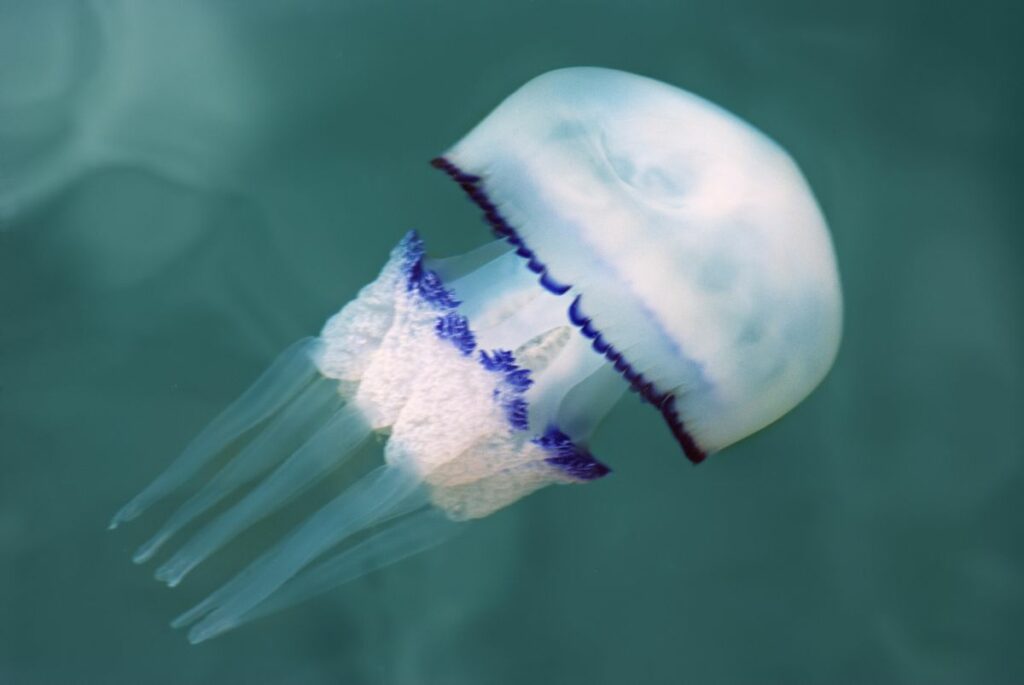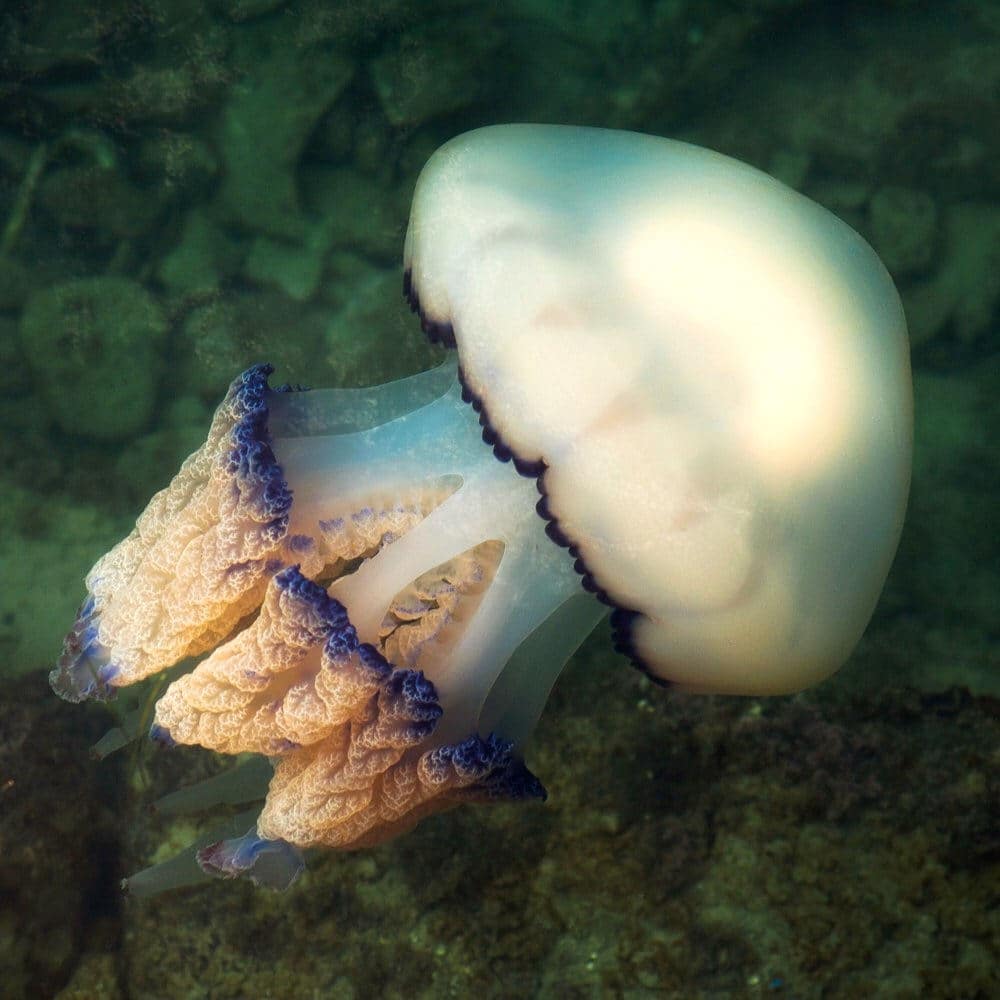The barrel jellyfish is one of the largest jellyfish in the world, and it is the largest jellyfish species in the United Kingdom.

The lion’s mane jellyfish, the largest jellyfish in the world, has a small bell with incredibly long tentacles. The barrel jellyfish has much shorter tentacles, but the tentacles and bell are thick. What the barrel jellyfish lacks in length, it makes up for in width and weight.
Oddly enough, barrel jellyfish don’t realize how big they are. Their underestimation traps them in shallow water, and they wash up on shore. So, if you live in the United Kingdom, or have visited in the summer, you’ve probably seen these jellyfish along the beaches.
What Is A Barrel Jellyfish?
According to The Wildlife Trust, barrel jellyfish are “large translucent jellyfish with a huge mushroom shaped bell and a bunch of 8 frilly tentacles below. They don’t have marginal tentacles but do have a violet fringe around the bell which contains sense organs.”
- Common Names: Barrel Jellyfish, Dust-Bin Lid Jellyfish
- Scientific Name: Rhizostoma pulmo
- Origin: In the Atlantic Ocean, off the west and south coasts of the United Kingdom
- Barrel Jellyfish Size (Length): 35.4 in (90 cm)
- Barrel Jellyfish Size (Weight): 77.2 lbs (35 kg)
- Life Expectancy: 12-18 months
As one of the biggest jellyfish in the world, the barrel jellyfish’s bell can reach the size of a dustbin lid. They weigh a considerable amount for the size of their bell. Their bell reaches 35.4 in (90 cm), but can weigh up to 77.2 lbs (35 kg).
The Game & Wildlife Conservation Trust also provides an interesting picture of the robust barrel jellyfish:
“Despite being 95% water, the barrel jellyfish appears fairly solid and opaque in comparison to other jellyfish, making it look rather like the mushroom cloud of an atomic bomb.”
Like their bodies, their tentacles are thick and robust as well, though they don’t look like it. They have eight thick arms covered by many tiny, stringy tentacles. The arrangement of these small tentacles over the large ones gives the jellyfish an appearance of a bulky feather duster, or cauliflower.
Their large bell is usually clear, but may sometimes be light yellow, pink, or blue. The edge of the bell is violet blue.
A barrel jellyfish sting is somewhat painful, though not usually dangerous to humans. Because they feed mostly on zooplankton, their sting is mild and much less painful than other jellyfish species.
Habitat
These big jellyfish prefer warm, coastal waters where zooplankton — their favorite meal — is abundant.
They enjoy warm water so much they often become washed ashore. Barrel jellyfish underestimate how big they are, and overestimate the depth of the water. They get trapped in water that is too shallow, can’t swim back out to sea, and become washed up on the beach.
You are most likely to see these jellyfish in the waters surrounding the United Kingdom from May to October. They head to the coastal waters in swarms of hundreds of jellyfish.
Over winter, researchers believe barrel jellyfish inhabit deeper waters off the coast. They likely prefer the warmer, shallower waters when it’s time to breed in the spring.

Diet
On the tentacles are hundreds of miniature mouths that the animal uses to eat its tiny prey: zooplankton and small fish. Most jellyfish have a single mouth at the base of their bell, but not the barrel jellyfish.
Zooplankton are microscopic animals, much smaller than the prey eaten by many other jellyfish species. To eat zooplankton, these gigantic jellyfish contain stinging toxins inside their mouthparts. They sting and then immediately eat the zooplankton using their many tiny mouths.
Reproduction
Jellyfish can reproduce both sexually and asexually, depending on their life stage. Juvenile polyps that live at the bottom of the ocean reproduce asexually, creating genetically identical clones of themselves.
Adult medusae reproduce sexually, each adult being male or female. Males release their sperm into the water while the female releases her eggs. Eggs become fertilized when the sperm contacts them, and they free-float through the ocean for a time before hatching and becoming larvae.
After some more development, the larvae develop into polyps that settle on the bottom of the ocean, and the life cycle begins anew.
Predators
Because of their sheer size, barrel jellyfish don’t have many predators. Their dominant predator is the leatherback turtle whose favorite meal is jellyfish. Leatherback turtles do not seem to mind the stinging venom of jellyfish.
Large sunfish are also formidable predators of the barrel jellyfish.
Conclusion
The barrel jellyfish is one of the world’s largest jellyfish, but its weight far overshadows its length. Eight thick tentacles hang from its large bell, and those tentacles contain hundreds of tiny, stinging mouths the jellyfish uses to eat zooplankton.
Barrel jellyfish are the largest jellyfish that live in the waters off the coast of the United Kingdom. They often underestimate their enormous size, washing up on the beaches over the spring, summer, and fall.
FAQs
Jellyfish stings are painful, no matter the species, but some species are far more damaging than others.
Barrel jellyfish eat microscopic zooplankton, so they don’t need a powerful sting. Their stings are still painful, but the pain is mild.
Box jellyfish are the most dangerous jellyfish on the planet, and their stings are excruciating. Death is rare, but not unheard of. Some people pass out from the pain of being stung, so drowning is a possibility. The toxins in their sting are also powerful enough to elevate blood pressure and cause cardiac arrest.
Jellyfish are carnivores who must eat, and they use mouths to take in their food. Most jellyfish species have a single mouth at the base of their bell. Just inside the mouth is a primitive stomach pouch they use to digest their food.
Barrel jellyfish have hundreds of tiny mouths on their eight tentacles that they use to eat microscopic zooplankton.
Yes, jellyfish can sting when dead, so you should never touch them.
Jellyfish contain cnidocytes in their tentacles, explosive cells that burst when you touch them. From the cells burst nematocysts, barbs that contain toxins that produce the painful sting. Cnidocytes and nematocysts can still fire after the jellyfish’s death if you touch them.
The world’s longest jellyfish is the lion’s mane jellyfish. These large animals reach lengths of up to 120 ft (36.6 m).
The International Union for the Conservation of Nature (IUCN) has not assessed the barrel jellyfish. There is no data to suggest the species may be endangered.
